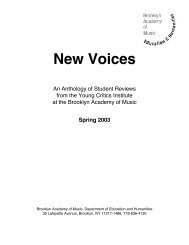The New Favela Beat - christopher reardon
The New Favela Beat - christopher reardon
The New Favela Beat - christopher reardon
Create successful ePaper yourself
Turn your PDF publications into a flip-book with our unique Google optimized e-Paper software.
THE NEW GLOBAL CITY<br />
<strong>The</strong> <strong>New</strong> <strong>Favela</strong> <strong>Beat</strong><br />
Crime has dropped dramatically in<br />
some of the most notorious favelas<br />
in the Brazilian city of Belo Horizonte,<br />
thanks to new policing techniques—<br />
and an unusual collaboration with<br />
young hip-hop artists. BY CHRISTOPHER REARDON<br />
PHOTOGRAPHS BY IERÊ FERREIRA<br />
Belo Horizonte, Brazil—Standing on a street corner in Pedreira Prado<br />
Lopes, one of this southeastern city’s roughest favelas, or slums, Lt. Col.<br />
Luciene Magalhães finds herself surrounded by smiling young faces.<br />
Even after 24 years on the police force, Magalhães describes the warm<br />
reception as a recent phenomenon. She attributes it to new policing<br />
strategies that have sharply cut the neighborhood homicide rate and<br />
begun to heal rifts between favelados and the police—two of Brazil’s<br />
least loved groups.<br />
“In the old police culture, we didn’t keep officers in the favelas,” she<br />
says, wearing a crisp khaki uniform, her long brown hair pulled back in<br />
a bun. “<strong>The</strong>y would just go there, look around and leave.” Today, she<br />
notes, “officers have a better appreciation of the community that lives<br />
inside the favelas, and the children in the favelas can see that we’re<br />
human beings.”<br />
Magalhães and her colleague, Lt. Col. Josué Soares—two of six military<br />
police commanders here in Brazil’s third largest city—have drawn<br />
national attention in recent months for introducing experimental policing<br />
techniques in their 700-officer units, the 22nd and 34th battalions.<br />
Some of these techniques are modeled on the methods that have cut<br />
crime so dramatically in <strong>New</strong> York City in the last decade: Compstat<br />
crime-mapping software and the shoe leather of community policing.<br />
But this highland metropolis has added a Brazilian twist by enlisting<br />
AfroReggae, a popular hip-hop ensemble from a notorious Rio favela,<br />
to conduct artist workshops with rank-and-file officers.<br />
Christopher Reardon has written for <strong>The</strong> Boston Globe, <strong>The</strong> <strong>New</strong> York Times, <strong>The</strong> Washington Post and other<br />
major publications.
At the invitation of Belo<br />
Horizonte’s 34th police<br />
battalion, a D.J. from<br />
the rap group NUC participated<br />
in a weeklong<br />
workshop designed to<br />
break down barriers<br />
between police and<br />
slum-dwelling youth.
<strong>The</strong>se innovations, supported by the Ford Foundation, are<br />
reaping rewards among the 2.3 million residents of Belo Horizonte,<br />
the capital of Minas Gerais state. For more than two decades, this<br />
state has pioneered new approaches to law enforcement.<br />
Such reforms are rare in Brazil, where the military police<br />
(who patrol the nation’s streets) and the civil police (who investigate<br />
crimes) maintain a pattern of repressive tactics and human<br />
rights abuses. In April, eight rogue officers in Rio de Janeiro<br />
were charged with murdering 30 favela residents in a shooting<br />
spree earlier this year. <strong>The</strong> aggressive police culture is widely<br />
Partners in Crime-Fighting<br />
<strong>The</strong> Ford Foundation’s support for police reform in Brazil<br />
reflects a commitment to strengthening that nation’s<br />
criminal justice system, a pillar of any democratic society.<br />
<strong>The</strong> AfroReggae Cultural Group, the Center for Studies on<br />
Public Security and Citizenship and the Center for Crime<br />
and Public Safety Studies advance this effort by showing<br />
that civil society can play an important role in helping<br />
police institutions become more responsive, effective<br />
and accountable to the public.<br />
viewed as a legacy of the dictatorship that ruled until the early<br />
1980’s, when the nation began a transition to democracy. Some<br />
critics trace the problems further back.<br />
“If you look back to the 19th century, the police were created<br />
in Brazil to protect slaveowners, not slaves,” notes Claudio<br />
<strong>Beat</strong>o, a policing expert at the Federal University of Minas<br />
Gerais.“In practical terms, their function was to fight poor people<br />
and protect rich people.” Some of the city’s policing reforms<br />
originated at the university’s Center for Crime and Public Safety<br />
Studies, a research institute that <strong>Beat</strong>o directs. <strong>The</strong> center (known<br />
by its Portuguese acronym, CRISP) has a staff of 36, with expertise<br />
in such fields as demography, spatial analysis, statistics, computer<br />
science, economics and sociology.<br />
“One of the problems in Brazil is the absence of good information<br />
about crime and violence,” says <strong>Beat</strong>o. “At CRISP, we’re<br />
working to help the military police take a more sophisticated<br />
approach. It’s easier to respond to crimes, and prevent them,<br />
when you know exactly where they tend to occur.”<br />
In the last six years, hundreds of officers have taken courses<br />
at the university in human rights, statistics, administration and<br />
related fields. Meanwhile, CRISP has helped military police set<br />
up a crime-mapping and analysis program, using computers<br />
Silvia Ramos, area<br />
coordinator at Brazil’s<br />
Center for Studies on<br />
Public Security and<br />
Citizenship (fourth from<br />
left), and members of<br />
the AfroReggae Cultural<br />
Group, with officers<br />
from Belo Horizonte’s<br />
22nd battalion after<br />
a workshop.<br />
20 Ford Foundation Report Spring/Summer 2005
Police officers and graffiti artists<br />
took a walk in each others’ shoes<br />
during a workshop created by<br />
AfroReggae and Belo Horizonte<br />
police department reformers.<br />
to plot the incidence of crime block by<br />
block, month by month. When the system<br />
was applied in Pedreira Prado Lopes,<br />
<strong>Beat</strong>o says, the homicide rate among its<br />
10,000 residents plummeted from the<br />
staggeringly high figure of 56 in the first<br />
nine months of last year.<br />
Data and aerial photographs showed<br />
that many shootings had taken place at<br />
the same intersection where Magalhães<br />
recently got friendly greetings. Police<br />
replaced an adjacent fence and trimmed<br />
nearby trees that had provided cover for<br />
assailants. A specially trained unit then<br />
arrested the most dangerous gang leaders<br />
and brokered a truce between their<br />
successors. In the three months that followed,<br />
only two homicides occurred there.<br />
In 2002, CRISP also had a hand in<br />
launching a successful homicide-reduction<br />
program, Fica Vivo! (Stay Alive!), in<br />
another favela with a high crime rate. A<br />
public-private partnership that originated<br />
in Soares’ battalion, this program was<br />
modeled in part on a highly successful cease-fire program brokered<br />
by clergy in Boston, Mass., seven years earlier. It has since<br />
expanded to 21 regions in Minas Gerais. Youth centers are a<br />
key feature, offering constructive alternatives to gang culture.<br />
<strong>The</strong> reforms hardly guarantee success, however. Crack cocaine<br />
is fueling a violent crime wave; citywide, homicides rose 9.8<br />
percent last year. But in neighborhoods patrolled by the battalions<br />
that embrace the new<br />
strategies most ardently,<br />
Soares says, homicides fell 25<br />
percent last year.<br />
Belo Horizonte sits on a<br />
high plain with striking alpine<br />
views. But despite its name,<br />
which means “beautiful horizon,”<br />
the city is a patchwork<br />
of privilege and poverty. Leafy<br />
streets lined with gated compounds<br />
adjoin makeshift<br />
communities where slum<br />
dwellers tap into municipal<br />
water and electrical supplies.<br />
At least 25 percent of the population lives in nearly 100 favelas,<br />
spreading steadily up the slopes of the Corral Mountains.<br />
Some are havens for heavily armed gangs controlling the<br />
drug trade, which has underpinned violent crime over the last<br />
two decades. From 1986 to 2004, for every 100,000 city residents,<br />
armed robberies soared from 97.3 to 422 and homicides<br />
climbed from 8.4 to 44.8.<br />
Yet these incidents are highly localized. <strong>The</strong> vast majority of<br />
<strong>The</strong> 23-year police veteran figured he’d<br />
mastered the tools of his trade: a twoway<br />
radio, handcuffs and a 9-millimeter<br />
service pistol. He never imagined that<br />
one day he’d add a bass drum or a can<br />
of spray paint.<br />
homicides occur within favelas, and most robberies take place<br />
a block or two outside. Moreover, a recent study found that 20<br />
percent of violent crime takes place in just six favelas. “People<br />
talk about an explosion of violence,” says <strong>Beat</strong>o. “Really it’s an<br />
implosion. It’s very focused in a few poor neighborhoods.”<br />
Officials like Magalhães and Soares are helping to make the<br />
police more responsive to crime data, more intent on preventing<br />
crimes and more accountable to the public—particularly<br />
to favelados. Two years ago, Soares introduced special units<br />
devoted to high-risk areas in the 22nd battalion. Now such units<br />
have spread to the 34th battalion and beyond.<br />
Soares, a plainspoken man wearing a black beret, says, “Not<br />
long ago, a lot of officers believed we had to use force to stop<br />
criminality. Our mentality has changed in the way we approach<br />
favelados.” <strong>The</strong> 23-year police veteran figured he’d mastered<br />
Ford Foundation Report Spring/Summer 2005 21
Police officers from<br />
the 34th battalion’s<br />
percussion group have<br />
added drums to their<br />
crime-stopping arsenal.<br />
the tools of his trade: a two-way radio, handcuffs and a 9-millimeter<br />
service pistol. He never imagined that one day he’d add<br />
a bass drum or a can of spray paint.<br />
<strong>The</strong>n last year, local officials got wind of an idea from Rio:<br />
AfroReggae, a hip-hop group from Vigário Geral (a favela so<br />
notorious it’s known simply as V.G.), proposed a series of artist<br />
residencies to ease tensions between young people and the<br />
police. <strong>The</strong> project failed to gain traction in Rio, but the Secretariat<br />
of Social Defense in Minas Gerais state offered to bring<br />
it to Belo Horizonte.<br />
<strong>The</strong> 22nd and 34th battalions enlisted<br />
AfroReggae to lead four weeklong<br />
encounters designed to dispel stereotypes<br />
that divide police and favelados. Band<br />
members trained officers in drumming,<br />
dancing, graffiti, video and circus arts. At<br />
two concerts, slum residents mingled with<br />
hundreds of officers and their families.<br />
<strong>The</strong> workshops build on the “peace artists”programs of recent<br />
years, in which hundreds of officers coach soccer or give music<br />
lessons in the favelas. <strong>The</strong>y seek to drive a wedge between criminal<br />
gangs and the law-abiding majority.<br />
<strong>Beat</strong>o calls the AfroReggae workshops “one of the most interesting<br />
processes of police reform in Latin America.”<strong>The</strong>y help, he<br />
adds, by “changing the misperceptions that keep police officers<br />
and young people from the slums locked in a tense relationship.”<br />
<strong>The</strong> band formed in 1993 after police gunned down 21<br />
bystanders in Vigário Geral. Coming just weeks after police<br />
killed eight street children sleeping on the steps of a historic<br />
church, the incident made headlines worldwide. It inspired José<br />
Júnior, a young D.J. who made ends meet by driving a taxi, to<br />
‘<strong>The</strong> sound you heard before was<br />
the sound of guns. Now what you<br />
hear is music.’<br />
join friends in launching AfroReggae, a loose ensemble of percussionists,<br />
guitarists, turntablists and vocalists who write<br />
bouncy, popular songs about hope and survival.<br />
“We wanted to take V.G. out of the headlines about violence<br />
and put it in the culture section of the newspaper,” says Júnior.<br />
22 Ford Foundation Report Spring/Summer 2005
Toni Garrido, a Brazilian<br />
pop star, left, joined<br />
AfroReggae’s Luiz<br />
Gustavo in a concert<br />
at Belo Horizonte’s<br />
34th police battalion.<br />
“<strong>The</strong> sound you heard before was the sound of guns. Now what<br />
you hear is music.”<br />
More than a band, the AfroReggae Cultural Group is a registered<br />
nongovernmental organization that runs youth centers<br />
in V.G. and another favela near the sands of Ipanema. Hundreds<br />
of adolescents spend afternoons making music and practicing<br />
circus tricks, and some start their own ensembles.<br />
Paulo Neguéba, a percussionist who led the police workshops<br />
in Belo Horizonte, is living proof that the band takes its message<br />
to heart. Driving through V.G. two years ago, he was caught<br />
in the crossfire of a police operation gone awry. He took four<br />
bullets in his legs and back, two other bystanders were injured<br />
and a third was killed in the assault, which resulted in the firing<br />
of the police commander.<br />
“At first I felt angry, like anyone would,” recalls Neguéba, who<br />
underwent three operations and months of physical therapy.<br />
“But now I have a broader perspective. I cannot combat evil<br />
with more evil.”<br />
<strong>The</strong> AfroReggae workshops yielded striking scenes of Belo<br />
Horizonte’s police creating music and art with rappers from<br />
Rio’s most notorious favela. <strong>The</strong>se new experiences changed<br />
the way police and youth see one another, how they see themselves<br />
and how they are seen by the larger society, says Silvia<br />
Ramos of the Center for Studies on Public Security and Citizenship.<br />
<strong>The</strong> center, based at Candido Mendes University in Rio,<br />
helped administer and document the workshops.<br />
“I’m always looking for tools that can change police behavior<br />
and attitudes,”says Ramos, who holds a doctorate in psychology.<br />
“I used to give them classes and lectures about respecting<br />
the human rights of the poor population, but that language<br />
wasn’t working. It created resistance and defensiveness. This<br />
project is much more powerful. It reaches them, not just through<br />
their minds, but in their hearts and in their bodies.”<br />
<strong>The</strong> workshops made headlines nationwide and soon will<br />
reach a wider audience through a photographic exhibit, a book<br />
and a television documentary. Moreover, there are plans to expand<br />
the program to all six battalions in Belo Horizonte this year, with<br />
additional support from the state government. This time,AfroReggae<br />
will be joined by local dance and drumming groups.<br />
As Lt. Cláudio Alves da Silva, a tactical officer in the 22nd<br />
battalion, observes, “Before we started these social programs,<br />
people in the favelas saw us as a major enemy. <strong>The</strong>y would shoot<br />
down into the battalion from the hillside.” He adds,“Now when<br />
we enter the favelas we get a good reaction.” <br />
Ford Foundation Report Spring/Summer 2005 23









